
A sandwich is a food typically consisting of vegetables, sliced cheese or meat, placed on or between slices of bread, or more generally any dish wherein bread serves as a container or wrapper for another food type. The sandwich began as a portable, convenient finger food in the Western world, though over time it has become prevalent worldwide.

Otto Frederick Rohwedder was an American inventor and engineer who created the first automatic bread-slicing machine for commercial use. It was first used by the Chillicothe Missouri Baking Company.

A baker is a tradesperson who bakes and sometimes sells breads and other products made of flour by using an oven or other concentrated heat source. The place where a baker works is called a bakery.

A baguette is a long, thin type of bread of French origin that is commonly made from basic lean dough. It is distinguishable by its length and crisp crust.

A bakery is an establishment that produces and sells flour-based baked goods made in an oven such as bread, cookies, cakes, doughnuts, bagels, pastries, and pies. Some retail bakeries are also categorized as cafés, serving coffee and tea to customers who wish to consume the baked goods on the premises. In some countries, a distinction is made between bakeries, which primarily sell breads, and pâtisseries, which primarily sell sweet baked goods.

Wonder Bread is an American brand of sliced bread. Established in Indianapolis, Indiana, in 1921, it was one of the first companies to sell sliced bread nationwide by 1930. The brand is currently owned by Flowers Foods in the United States.
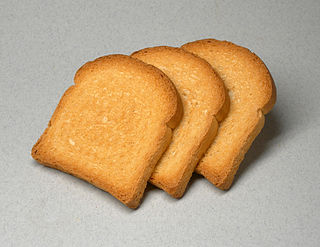
A rusk is a hard, dry biscuit or a twice-baked bread. It is sometimes used as a teether for babies. In some cultures, rusk is made of cake, rather than bread: this is sometimes referred to as cake rusk. In the UK, the name also refers to a wheat-based food additive.

A bread making machine or breadmaker is a home appliance for baking bread. It consists of a bread pan, at the bottom of which are one or more built-in paddles, mounted in the center of a small special-purpose oven. The machine is usually controlled by a built-in computer using settings input via a control panel. Most bread machines have different cycles for different kinds of dough—including white bread, whole grain, European-style, and dough-only. Many also have a timer to allow the bread machine to function without operator input, and some high-end models allow the user to program a custom cycle.

Cuban bread is a fairly simple white bread, similar to French bread and Italian bread, but has a slightly different baking method and ingredient list ; it is usually made in long, baguette-like loaves. It is a staple of Cuban-American cuisine and is traditionally the bread of choice when making an authentic Cuban sandwich.
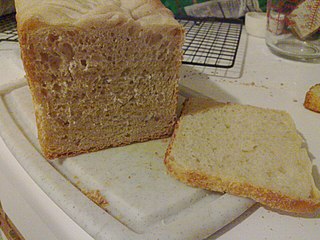
The Pullman loaf, sometimes called the "sandwich loaf" or "pan bread", is a rectangular loaf of white bread baked in a long, narrow, lidded pan. The French term for this style of loaf is pain de mie, or, less commonly, pain anglais.
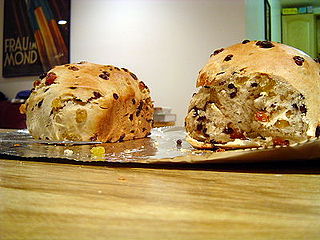
Barmbrack, also often shortened to brack, is a yeast bread with added sultanas and raisins. The bread is associated with Halloween in Ireland, where an item is placed inside the bread, with the person receiving it considered to be fortunate.
Warburtons Limited is a British baking firm founded by Thomas Warburton in 1876 and based in Bolton, a town formerly in Lancashire, England, and now in Greater Manchester. For much of its history Warburtons only had bakeries in Lancashire and it remains a family-owned company. As of 2018, Warburtons has 12 bakeries, 14 depots, and 4,500 employees around the UK.

Yazdani Bakery is an Irani cafe or Persian style bakery in Mumbai, India. As of 2023, it is a take-out establishment with the sit-down service closed.
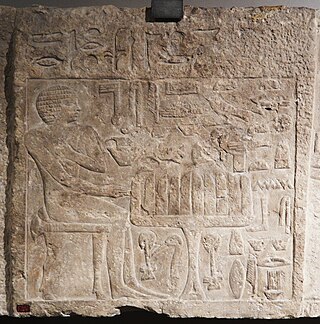
Bread was central to the formation of early human societies. From the Fertile Crescent, where wheat was domesticated, cultivation spread north and west, to Europe and North Africa, and east towards East Asia. This in turn led to the formation of towns, as opposed to the nomadic lifestyle and gave rise to more and more sophisticated forms of societal organization. Similar developments occurred in the Americas with maize and in Asia with rice.
The history of California bread as a prominent factor in the field of bread baking dates from the days of the California Gold Rush around 1849, encompassing the development of sourdough bread in San Francisco. It includes the rise of artisan bakeries in the 1980s, which strongly influenced what has been called the "Bread Revolution".

Holsum Bread is an American brand of packaged sliced white bread. The Holsum name was being used by many retail bakeries, independently, around the country by the early 1900s. In 1908, the W. E. Long Company of Chicago acquired exclusive national rights to the name and formed a cooperative of bakeries to market a single recipe under the brand name Holsum in various cities.
Bread is a staple food throughout Europe. Throughout the 20th century, there was a huge increase in global production, mainly due to a rise in available, developed land throughout Europe, North America and Africa.
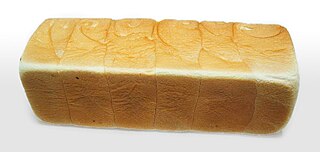
Japanese milk bread, also called Hokkaido milk bread, or simply milk bread in English sources, is a soft white bread commonly sold in Asian bakeries, particularly Japanese ones. Although bread is not a traditional Japanese food, it was introduced widely after World War II, and the style became a popular food item.

Western India Baker's Association (Wibs) is a brand of bread originated in Mumbai, India in 1973. It has been a staple in many Mumbai households and is especially favored by local sandwich makers. In 2019 it had a 46% market share of Mumbai's sliced bread market.




















